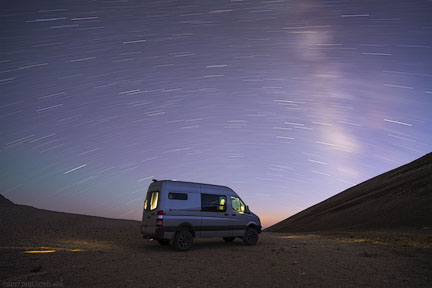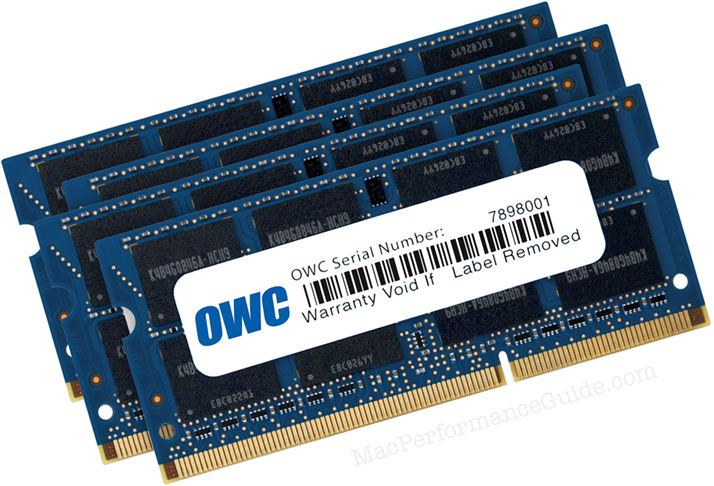Mercedes Sprinter Alternator: Amperage Output with Real Loads, Voltage, Charging Rate for Lithium Battery

Photographer and cyclist and Mac expert and software engineer Lloyd Chambers is available for consulting on general Sprinter considerations at his usual consulting rates via phone, or in person in the Palo Alto, CA area. Save yourself hours and mistakes by discussing issues up-front. More about Lloyd....
Get your batteries and 2nd alternator and regulator (the whole kit!) from NationsStarterAlternator.com.
See also Mercedes Sprinter Battery, Wiring Panel, Inverter as Installed.
Everything I’ve heard about the stock Mercedes Sprinter alternator is that it is rock solid. That’s what I want way down a dirt road (reliability), what I want for charging my 400 amp battery (fast reliable charging), and for running a 1500 watt space heater (delivers enough power at idle to almost run the heater on its own).
General notes
The 2017 Mercedes Sprinters 3.0L 6 cylinder stock alternator outputs amperage that corresponds to the voltage it senses. My Sprinter wires the 5 kilowatt Lithionics battery from the Sprinter auxiliary battery terminals via dual 1' cables (equivalent to one 4-ought cable). The voltage that the alternator senses is whatever those batteries and cables present, along with any load/draw on the system.
- If the battery is fully charged, the voltage is maximal, and the Lithionics battery BMS simply takes no charge (Lithionics status panel shows 0 amps).
- If the battery is mostly charged (60% SoC or more) and there is no load, the alternator will generate 35 to 55 amps for charging, depending on the voltage is it seeing. Since it sees a
- If the battery is mostly discharged (10% to 60% SoC), the voltage is still relatively high with the Lithionics battery (it maintains a quite flat voltage curve). Still, it might be 0.1V lower and so the alternator will generate up to about 65 amps for charging (perhaps more if discharged by 80% or more, but that is a case I’ve had little opportunity to test).
- If the voltage drops substantially, say from 13.6V to 12.8V by running an 1900 watt load drawing 170 DC amps (e.g., 1500W space heater + computer + inverter overhead), the alternator will output up to about 115 amps at 800 rpm peaking as high as 130 amps or so (at idle) for shorter periods in cold conditions.
Bottom line is that due to voltage sensing, there is no fast charge with high amps when the battery is mostly charged. This is presumably a GOOD thing for longevity, giving the BMS a chance to balance charge across cells via shunting, but if the goal is to quickly get from say 80% to 100% charge, it’s not going to happen all that fast (35 to 45 amps is all you’ll get).
One intriguing product that I have not tried but that might triple or quadruple the charge rate with the stock Sprinter alternator is the Sterling Power Alternator-to-Battery Charger. Basically, it "fakes" low voltage so that the alternator pumps out many more amps. It then raises the voltage sent to the batteries. Thus far more power is delivered from charging. In essence it does what the space heater does as described further on—drops the voltage so that the alternator works at much higher output. Considerable fuel would be saved and charging while idling (or driving) would be sped up massively.
With shore power charging via the Xantrex Freedom XC inverter charger, 80 amps is sent as a constant input in BLK charge mode right up to 99% SoC, followed by a short ABS cycle, then FLT mode in which no amperage is sent. Whether such rapid shore power charging versus slower alternator charging from, say, 70% or higher SoC is a good or bad thing for the battery is not clear to me.
Operating note observations
2017 Mercedes Sprinter 4x4 at idle at about 60°F and 50% humidity
- At a temperature of about 60°F, the Mercedes Sprinter alternator can deliver up to 113 amps while idling at only 800 rpm. The actual output depends on the load demand.
- With the engine idling at only 800 rpm, a 1500 watt space heater can operate while depleting the battery by only about 16 amps (130 watts). The alternator is delivering almost enough power at idle to power a 1500 watt space heater.
- With the engine idling, a 785 watt space heater can operate while also charging the battery at about +22 amps (~210 watts).
- Sprinters with high idle capability likely can power a 1500 watt space heater while also charging the battery.
- The
I feel rather smug about having rejected solar, given these findings. The alternator power over one hour while idling exceeds what one might get from dual 160W solar panels in an entire summer day. Add in the increased fuel consumption from wind drag on the solar panels and rack around them, and solar is almost certainly a huge net energy loss (the 'hit' is any and every time one drives), at least on a Sprinter. That is, solar is most likely anti 'green'—mental masturbation when it comes to net energy gain/loss.
Real world test details: 800W / 1500 watt electric heater

For this test, I used the Aerus Apollo 2000 Infrared Space Heater @AMAZON. Actual wattage draw varies changes as the temperature approaches the set value (the space heater cuts output down).
Wattage and amperage are displayed by the Lithionics status panel. The Xantrex Freedom XC status panel shows wattage as well; a simple ratio yields efficiency.
With the engine off, running the space heater at full power with the engine off rapidly draws down the Lithionics 400 amp battery in my Sprinter. The Xantrex Freedom XC was showing 1480 watts AC output while the Lithionics battery status panel showed 131 amps DC @ 12.8V = 1676 watts, for a DC-AC conversion efficiency of 88%. At that rate, it would be 2.4 hours to drain the battery by 80% down to 20% charge. Clearly, a space heater is not a great idea if the batteries have to supply all the power.
Then I wondered what would happen with the engine on. I was not expecting much, perhaps 60 amps (about 840 watts). That would be enough to idle the engine while running the space heater at its 800 watt setting.
I observed these behaviors over the course of 30 minutes. There was some initial variability but once the engine warmed up, the behavior was extremely consistent.
The alternator apparently raises its game when it senses a demand load! Here is what I found:
- Space heater high setting: with the Xantrex Freedom XC delivering 1480 watts AC output, the voltage sat at a steady 13.0 volts. Assuming 88% efficiency, that implies 129 DC amps @ 13.0 volts (1480/.88/13.0 = 129). The Lithionics status panel showed a net draw of only 16 amps, which implies that the Mercedes Sprinter alternator was delivering at idle (129 - 16) = 113 amps, or 1470 watts.
- Space heater low setting: with the Xantrex Freedom XC delivering 785 watts AC output, the voltage sat at steady 13.3 volts. Assuming 88% efficiency, that implies 67 DC amps @ 13.3 volts (785/.88/13.3 = 67). The Lithionics status panel showed a net charge of +22 amps, which implies that the Mercedes Sprinter alternator was delivering at idle (67+22) = 89 amps, or 1183 watts. In other words, an 800 watt space heater can be run while idling and still charge the battery!
These findings suggest that while a good propane heater seems appealing, a 800/1500 watt electric heater is a great idea if one can idle the engine for a reasonable amount of time and/or if heating needs are not substantial. Plus there is zero risk of carbon monoxide poisoning with an electric heater, and less risk with engine idling than an interior propane heater.
Other notes:
- Over the 30 minutes or so of this test, the Xantrex Freedom XC ran its fans, but it stayed cold to the touch everywhere on its metal exterior (some hot air came out the rear).
- The headlights were off (except for the low lights the Sprinter always keeps on when running and parked). The AC was off, the cabin heating was off.
- Once the engine warmed up, the AC output and DC output values was seen to vary only by no more than 1%.
At much lower cost than Apple, with more options.
Lloyd recommends 64GB for iMac or Mac Pro for photography/videography.
Charging speed and capacity
The Xantrex 3012 was used for this test; I switched to the Xantrex Freedom XC right after this drive to Los Angeles to ADF Sprinters.
This test also used a single 1/0 cable from the alternator (aux battery terminals) to the Lithionics battery. So the alternator is pushing current through the starter battery (1/0 cable) and then through another 1/0 cable to the aux battery, then a 12-foot 1/0 cable to the Lithionics battery. One purpose of this trip was to add another 1/0 cable to the Lithionics battery, thus making the equivalent of a 4/0 cable.
Driving to Los Angeles in mid-September with temperatures around 90°F, I left home with the Lithionics status panel indicating 48% SoC (State of Charge). I checked the SoC at intervals.
Time: SoC Avg Speed 00:00 48% n/a 01:07 64% 43 mph (stop and go) 02:46 84% 50 mph (~55 to 65 mph, 2000 to 2400 rpm typical) 04:24 100% 52 mph (~58 to 65 mph, 2000 to 2400 rpm typical)
I was disappointed that charging speed was only about half of what it ought to be: were there 100 amps going into the battery (~1400 watts), one hour should raise SoC by about 27% (1400/5120). Clearly it’s not the simple.
Still, I was delighted to find that the Lithionics 400 amp battery had charged to 100%—not the 90 to 95% I had been told to expect by Lithionics.



